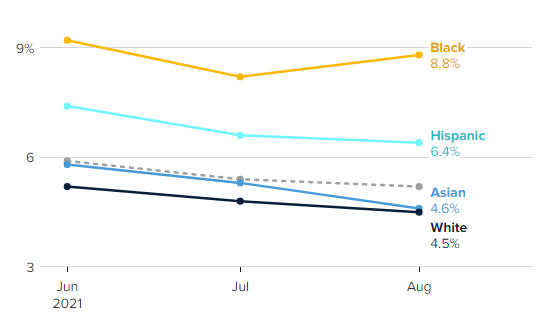Black unemployment rises in jobs report despite more job seekers
Employers added only 235,000 payrolls last month, far fewer than the 720,000 expected. The unemployment rate dropped to 5.2 percent from 5.4 percent, in line with estimates. But the August 2021 jobs report showed that Black workers are facing an even bigger struggle to find employment compared with job seekers of other races.
But the rate of unemployment among Black workers rose in August to 8.8 percent from 8.2 percent in July. The white unemployment rate, meanwhile, fell to 4.5 percent from 4.8 percent and the Asian unemployment rate dropped to 4.6 percent from 5.3 percent.
The unemployment rate for Hispanic and Latino workers inched lower to 6.4 percent from 6.6 percent.
A majority of economists and President Joe Biden pointed to the growing number of cases of the Covid-19 delta variant for sluggish overall job numbers. Experts have also pointed to a retreat in consumer confidence for the slowdown in hiring.
The increase in Black unemployment is even more troubling in light of the fact that the labor force participation rate among Black workers rose last month and is about tied with the rate for white workers at 61.6 percent.

In other words, despite a greater percentage of Black people either working or looking for work, a greater proportion were unable to land a job.
Employers are the problem, said AFL-CIO chief economist William Spriggs, former chair of Howard University’s economics department. He noted that, in August, the unemployment rate among Black workers with associate degrees exceeded that of white high school dropouts.
Specifically, Black workers with an associate degree saw an unemployment rate of 6.9 percent, while the jobless rate among white high school dropouts was 5.8 percent. The unemployment rate across all races for people without high school diplomas who are 25 and over was 7 percent, while the jobless rate for Black people with high school diplomas in the same age category was 10 percent. These numbers challenge the long-held belief that greater educational achievement will be rewarded in the workplace.
“A lot of people find jobs, but a bigger share of those who went out looking didn’t. So, the Black unemployment rate has been going up because employers are still passing over Black workers,” Spriggs told CNBC on Friday. “When you look at those numbers, it’s clear employers are saying, ‘We want workers, but not exactly.’”
Spriggs’ comments refer to the widespread complaint among U.S. employers that they are unable to find workers to fill a record number of job openings. The Labor Department reported last month that job openings roared to a record 10.1 million on the final day of June.
Some employers, and especially restaurants, are scrambling to entice would-be workers with pay increases, signing bonuses and more generous benefit plans.
Walmart, for example, said Thursday it is raising hourly wages for more than 565,000 store workers by at least $1. These incentives have to be significant enough, though, to help ease the barriers that are keeping people from working, said Dr. Kristen Broady, a fellow in economics studies at the Brookings Institution and policy director of the think tank’s Hamilton Project.
“Is it enough to cover child care?” she asked. “Are you increasing wages enough for people to be able to cover costs of being able to get to that job?”
Business leaders, including the CEO of the Chamber of Commerce, have blamed a lack of skilled labor, Covid-era jobless benefits and a lack of child care for employers’ struggles.
However, Spriggs said the stubbornly high unemployment rate among Black workers has one primary explanation — discrimination.
“When you see Black workers struggling but the labor market doing well, that’s a sign of employers showing their preference,” Spriggs said.
This story was originally published on CNBC.com.
